Kinematics - Distance & Displacement
In this article, we will learn about the following topics:
- Distance & Displacement
- Speed & Velocity
- Acceleration
Scalars and Vectors
Scalars and vectors are two types of physical quantities.
| Scalar Quantities | Vector Quantities |
|---|---|
| Have only magnitude | Have both magnitude and direction |
Distance & Displacement
Distance is the total length covered by a moving object along the path taken. The direction of motion does not matter.
Displacement is the straight-line distance covered by a moving object regardless of the path taken. It takes into account only the starting and the ending points.
The direction of the motion, relative to a reference point, needs to be specified. It mainly needs the starting point to be specified.
Let us consider two points A and B. The car travels the distance as shown in the figure below.
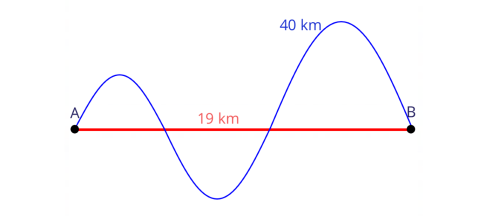
The distance travelled by the car is 40 km.
The displacement of the car is 19 km to the right of A.
Let us consider another example.
We have a car that moves from A to B and then from B to A.

The distance travelled is 38 km.
The displacement of the car is 0 km.
The displacement is a straight-line distance between the starting and ending point. The starting point and the ending point are the same, so the displacement of the car is zero. Since the displacement is zero, the direction is not required.
Let us consider another scenario.
There are three points A, B and C. First, the car moves from point A to B and then it returns from B to C.
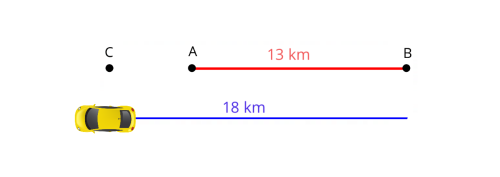
The distance travelled is 31 km.
The displacement of the car is 5 km to the left of A.
Positive & Negative Displacement
For an object moving in a straight line, we can assign one direction from the reference point as the positive direction.
The opposite direction will be the negative direction.
There are no fixed rules for assigning directions. Positive and negative directions are assigned purely for convenience.
Let us consider the following example to understand this better.
We have three points A, B and C. The car starts from Point A and reaches Point B. Then it changes direction and moves from Point B to Point C.

Taking right as the positive direction,
Displacement of the car is – 5 km.
The displacement is negative because the car is moving in the left direction. If the car were moving in the right direction, then it would have been positive as we have considered right as the positive direction.
Let us consider the following:
Taking left as the positive direction,
Then the displacement of the car will be 5 km.
Practice Questions
Question 1:
A boy walks 35 m to the east and then 13 m to the west. What is the distance travelled by him and the magnitude of his displacement?

Solution:

Distance Travelled
= 35 m + 13 m
= 48 m
Displacement
= 35 m − 13 m
= 22 m east
Since the question asked only for the magnitude of the displacement, it is 22 m. We need not mention the direction of the displacement.
Question 2:
A girl runs 60 m to the west and then 80 m to the north. What is the distance travelled by her and the magnitude of her displacement?
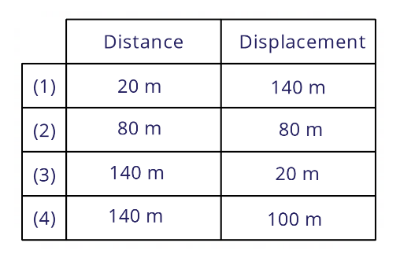
Solution:

Distance Travelled
= 60 m + 80 m
= 140 m
Displacement
\(= \sqrt {60² + 80²}\)
\(= \sqrt {3600 + 6400}\)
= \(= \sqrt {10000}\)
= 100 m NW direction
Since the question asked only for the magnitude of the displacement, we write 100 m.
Speed
Speed is the distance moved per unit of time.
\(\small \displaystyle{\textsf{Speed} = \frac {\textsf{Distance Travelled} }{\textsf{Time Taken}}}\)
It is a scalar quantity.
SI unit of speed is metre per second (m s⁻¹)
Another commonly used unit of speed is kilometre per hour (km h⁻¹) but it is not an SI unit.
Question 3:
A woman must reach the airport which is 91 km away from her house in two hours. She has a tea break for half an hour and spends one-fifth of an hour stationary in a traffic jam. At what average speed must she travel during the rest of the time if she wants to complete the journey in two hours?
Solution:
Time left to travel
= 2 h - 0.5 h - 0.2 h
= 1.3 h
Average speed
= \(\displaystyle{\frac {91 km}{1.3 h}}\)
= 70 km h⁻¹
Velocity
Velocity is the rate of change of displacement.
\(\displaystyle{\textsf{Velocity} = \frac{\textsf{Displacement}}{\textsf{Time Taken}}}\)
It is a vector quantity.
SI unit of velocity is metre per second (m s⁻¹)
Velocity has both magnitude and direction.
If the direction of travel has changed, velocity will change even if the speed remains the same.

We can see from the above figure, even though the speed of the car has not changed, the direction of the car has changed. Thus, velocity has changed.
Speed & Velocity
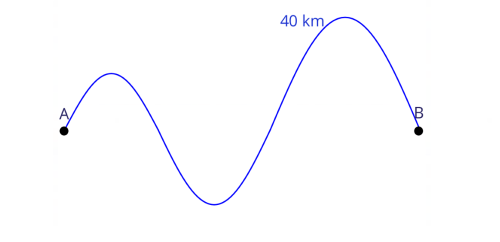
If the whole journey took 2 hours, then the average speed is:
Average speed = \(\displaystyle{\frac {40}{2}}\)
= 20 km h⁻¹

If the journey took 2 hours, and taking right as positive, what is the velocity of the car?
Average velocity = \(\frac {19}{2}\)
= 9.5 km h⁻¹
(Since it is already mentioned that right is positive, we are not mentioning the direction of the velocity.)
Let us see another example.

If the journey took 2 hours, what is the average speed and average velocity?
Average Speed = \(\frac {19\;+\;19}{2}\)
= 19 km h⁻¹
Average Velocity = \(\frac {19\;-\;19}{2}\)
= 0 km h⁻¹
( It is zero because displacement is zero. The starting and the ending point are the same.)
Question 4:
Sally walks 10 m to the south in 4 s followed by another 12 m to the east in 6 s. What is her average speed and the magnitude of her velocity?
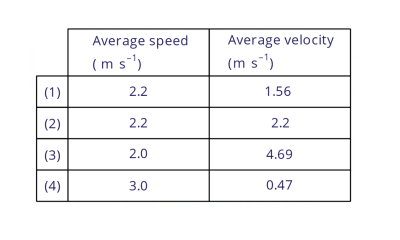
Solution:
Option 1 is the correct answer
Average Speed = \(\frac {10\;+\;12}{4\;+\;6}\)
= 2.2 m s⁻¹
Taking East and South as the positive direction,
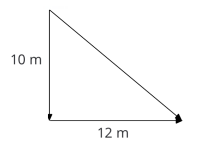
Displacement = \(\sqrt {{10^2} + {12^2}}\)
Displacement = 15.620 m
Velocity = \(\frac {15.620}{4\;+\;6}\)
= 1.56 m s⁻¹
Question 5:
John runs a circular path of radius 60 m. He completes one round in 2 minutes. Find the distance travelled by him and his average velocity.
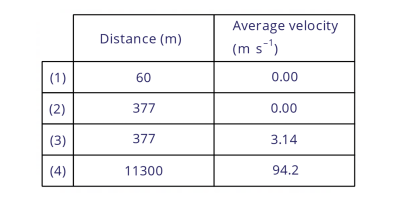
Solution:
Option 2 is the correct answer
Distance ran = \(2\pi r\)
= \(2 \times π \times 60\)
= 377 m
Displacement = 0 m since he returned to his original position.
Average Velocity = 0 m s⁻¹
Acceleration
Acceleration is the rate of change of velocity. In other words, it means how fast the velocity is changing.
\(Acceleration = \frac {Change \;In \;Velocity} {Time \;Taken}\)
It is a vector quantity.
SI unit of acceleration is metre per second per second (m s⁻²)
A body accelerates when its velocity changes.
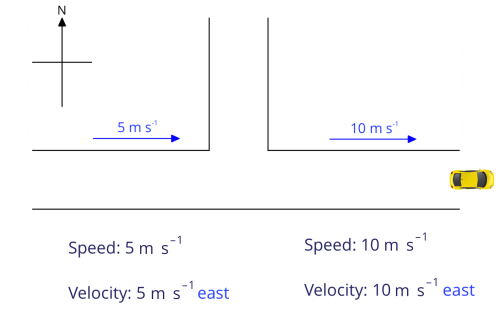
Since the magnitude of the velocity has increased, the car has undergone acceleration.
Let us see another example.
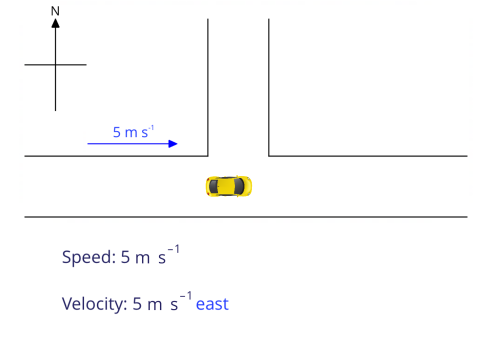
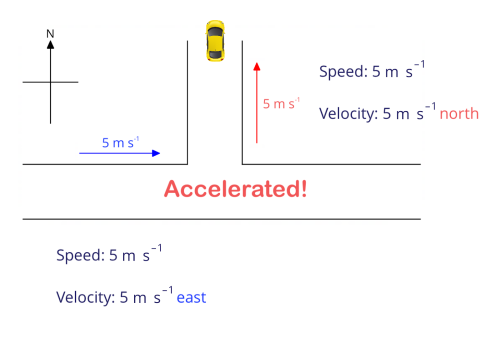
We see in the above figure that even though the magnitude of velocity has not changed, the direction of the velocity has changed. Hence, the velocity has changed.
Since the car has undergone velocity change, the car is said to have accelerated.
This acceleration is dealing with the change in direction and not the magnitude. This is called directional acceleration.
Let us see another scenario.
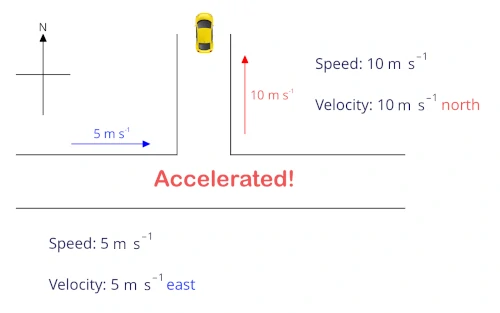
The car in the above figure is said to be accelerated since both the speed and the direction have changed.
Thus, we see that acceleration can come in two forms -
- Change in speed
- Change in direction
Acceleration & Deceleration
Acceleration
Acceleration, when it is uniform, can be calculated using the formula below.
\(a = \frac {v\;-\;u}{∆t}\)
Where,
\(a\) = acceleration;
\(v\) = final velocity;
\(u\) = initial velocity;
\(∆t\) = time interval.
For the O-level syllabus, the calculation of acceleration only deals with the change in the magnitude of the velocity and not the change in the direction of the velocity.
Question 6:
A train decelerates from 50 m s⁻¹ to 25 m s⁻¹ in 5 s. What is its acceleration?
Solution:
\(a = \frac {v\;-\;u}{∆t}\)
Here,
\(v\) = 25 m s⁻¹
\(u\) = 50 m s⁻¹
\(∆t\) = 5 s
So,
\(a\) = \(\frac {25 \;-\;50}{5}\)
= − 5 m s⁻²
What is the deceleration?
Deceleration = 5 m s⁻²
Conclusion
In this article, we have covered the following topics as per the Secondary 3 Physics syllabus.
- Distance & Displacement
- Speed & Velocity
- Acceleration
| Continue Learning | |
|---|---|
| Light - Reflection | Units and Measurements |
| Kinematics - Distance & Displacement | Dynamics |
| Mass, Weight & Density | Thermal Properties Of Matter |
| Moments | Temperature |
| Kinetic Model of Matter | Waves |
| Work, Power & Energy | Pressure |
| Transfer Of Thermal Energy | |
 SG
SG  VN
VN 













